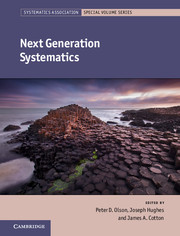Book contents
- Frontmatter
- Contents
- List of contributors
- Introduction: studying diversity in an era of ubiquitous genomics
- Part I Next Generation Phylogenetics
- Part II Next Generation Biodiversity Science
- 6 Perspective: Après le déluge: ubiquitous field barcoding should drive 21st century taxonomy
- 7 Perspective: Biodiversity and the (data) beast
- 8 Next generation biodiversity analysis
- 9 Protist systematics, ecology and next generation sequencing
- Part III Next Generation Challenges and Questions
- Index
- Systematics Association Special Volumes
- Plate section
- References
9 - Protist systematics, ecology and next generation sequencing
from Part II - Next Generation Biodiversity Science
Published online by Cambridge University Press: 05 June 2016
- Frontmatter
- Contents
- List of contributors
- Introduction: studying diversity in an era of ubiquitous genomics
- Part I Next Generation Phylogenetics
- Part II Next Generation Biodiversity Science
- 6 Perspective: Après le déluge: ubiquitous field barcoding should drive 21st century taxonomy
- 7 Perspective: Biodiversity and the (data) beast
- 8 Next generation biodiversity analysis
- 9 Protist systematics, ecology and next generation sequencing
- Part III Next Generation Challenges and Questions
- Index
- Systematics Association Special Volumes
- Plate section
- References
Summary
Protist taxonomy in context
The increasing availability over the past two decades of gene sequence data for protists has fired an energetic and rapidly moving field of taxonomic development and debate, in response to many exciting and often very surprising findings. The classic subdivisions of microbial eukaryotes into four main groups – amoeboid organisms, flagellates, ciliates and sporozoa (a group of parasites) – formulated in the 19th century and current throughout a large part of the 20th appeals because of its simplicity, but almost could not be more wrong. The history of protist taxonomy is not the subject of this chapter, but a diversity of perspectives can be found in (among others) Adl et al. (2005; 2007; 2012), Cavalier-Smith (1998), Corliss (1984), Levine et al. (1980), Walker et al. (2011) and references therein. There are several characteristics of protists that have contributed to this taxonomic turbulence. Their size makes detailed observation non-trivial; individual approaches, skills and tools applied to morphological taxonomic studies have varied significantly over time, and continue to do so. Their single-celled and/or non-differentiated forms do not offer many easily observable characters for either the taxonomist or natural selection to work on. A consequence of the latter is extremely high levels of convergent evolution at different evolutionary scales. Some very striking examples of convergence have been revealed by molecular phylogenetic analyses, which demonstrate the extent to which the pre-molecular subdivision of protists was incorrect (e.g. Nikolaev et al. 2004; Richards and Talbot 2007; Richards et al. 2011; S. D. Brown et al. 2012).
Some other important factors contributing to taxonomic difficulties are (1) the unknown sexual status of most protists and therefore the inapplicability and/or uncertainty of applying the biological species concept (sex is known for some but many are presumed asexual at least in the mid to long term), (2) highly incomplete and patchy knowledge of the diversity of many protist groups and regions of the eukaryote Tree of Life in which knowledge of lineage diversity and biology is generally poor, (3) the absence of a generally agreed or applicable species concept for most protist groups, and (4) difficulty of culturing many lineages.
- Type
- Chapter
- Information
- Next Generation Systematics , pp. 195 - 216Publisher: Cambridge University PressPrint publication year: 2016

